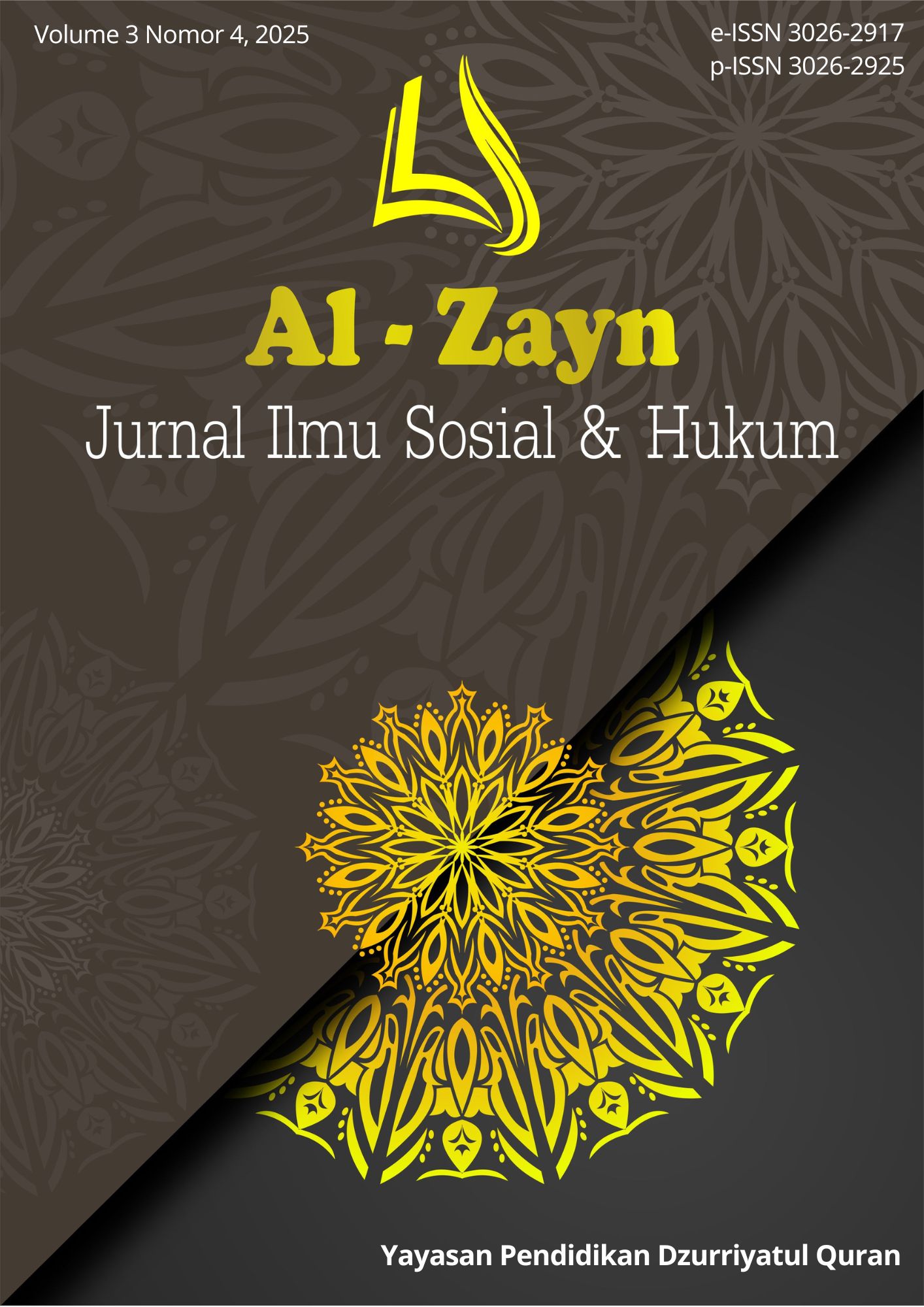Pengaruh Efikasi Diri Terhadap Niat Kewirausahaan Narapidana di Lapas Kelas IIA Pekanbaru
DOI:
https://doi.org/10.61104/alz.v3i4.2076Keywords:
Efikasi diri, niat kewirausahaan, narapidana, lembaga pemasyarakatanAbstract
Tingginya angka residivisme di Indonesia berkaitan erat dengan keterbatasan akses pendidikan, pelatihan kerja, dan stigma sosial yang membebani narapidana setelah bebas. Upaya pemberdayaan melalui kewirausahaan diyakini mampu menjadi strategi efektif untuk membekali narapidana dengan keterampilan, kemandirian ekonomi, serta mengurangi risiko pengulangan tindak pidana. Penelitian ini bertujuan untuk menganalisis pengaruh efikasi diri terhadap niat kewirausahaan narapidana di Lapas Kelas IIA Pekanbaru. Metode penelitian menggunakan pendekatan kuantitatif dengan menyebarkan kuesioner kepada 55 narapidana, kemudian data dianalisis melalui regresi linear sederhana menggunakan SPSS 25. Hasil penelitian menunjukkan bahwa efikasi diri berpengaruh positif dan signifikan terhadap niat kewirausahaan, dengan koefisien determinasi sebesar 33,5%. Temuan ini menegaskan bahwa penguatan efikasi diri melalui program pelatihan kewirausahaan dapat menjadi langkah strategis untuk menekan residivisme dan mendukung reintegrasi sosial narapidana. Penelitian ini diharapkan memberi kontribusi pada pengembangan teori kewirausahaan dalam konteks pemasyarakatan serta menjadi masukan praktis bagi pengelola lapas dalam merancang program pembinaan yang lebih berkelanjutan
References
Bandura, A. (1997). Self-efficacy: The exercise of control. W. H. Freeman & Company.
Creswell, J. W. (2009). Research design: Qualitative, quantitative, and mixed methods approaches (3rd ed.). Sage.
Creswell, J. W. (2018). Research design: Qualitative, quantitative, and mixed methods approaches (5th ed.). Sage.
Feist, J., & Feist, G. J. (2006). Theories of personality. McGraw-Hill.
Cole, G. F., & Clear, T. R. (1997). American corrections. Wadsworth.
Lambing, P. A., & Kuehl, C. R. (2003). Entrepreneurship. Pearson. https://lib.ui.ac.id/detail?id=20145759
Nurhasanah, S. (2019). Praktikum statistika 2 untuk ekonomi dan bisnis. Salemba Empat.
Nurhasanah, S. (2022). Praktikum statistika 1 untuk ekonomi dan bisnis. Salemba Empat.
Quigley, M. (2005). Information security and ethics: Social and organizational issues. Idea Group Publishing. https://doi.org/10.5860/choice.42-3464
Agustina, I., Hidayat, Z., & Sulistyan, R. B. (2021). Pengaruh program pelatihan dan motivasi terhadap minat berwirausaha narapidana pada Lembaga Pemasyarakatan Kelas IIB Lumajang. Jobman: Journal of …, 4(1), 66–71. https://jkm.itbwigalumajang.ac.id/index.php/jrm/article/view/562
Ajzen, I. (1991). The theory of planned behavior. Organizational Behavior and Human Decision Processes, 50(2), 179–211. https://doi.org/10.1016/0749-5978(91)90020-T
Akhtar, Z., & Golra, O. (2021). Prison-based entrepreneurial education programs & the Muslim world: A review and research agenda. Journal of Grou, 23529(2), 199–215.
Arifin, Z., Syam, A. Y., & Maladi, M. (2013). The models of human resource development in preparing prisoners for entrepreneurship in Banjarmasin. Asia Pacific Management and Business Application, 2(2), 84–97. https://doi.org/10.21776/ub.apmba.2013.002.02.1
Audet, A. (2012). Perceived job readiness among the previously incarcerated. Honors Projects, 53. https://digitalcommons.ric.edu/honors_projects
Bandura, A. (2000). Exercise of human agency through collective efficacy. Current Directions in Psychological Science, 9(3), 75–78. https://doi.org/10.1111/1467-8721.00064
Bird, B. (1988). Implementing entrepreneurial ideas: The case for intention. The Academy of Management Review, 13(3), 442–453. https://doi.org/10.2307/258091
Bygrave, W. D., & Hofer, C. W. (1992). Theorizing about entrepreneurship. Entrepreneurship Theory and Practice, 16(2), 13–22.
Ciptono, W. S., Anggadwita, G., & Indarti, N. (2023). Examining prison entrepreneurship programs, self-efficacy and entrepreneurial resilience as drivers for prisoners’ entrepreneurial intentions. International Journal of Entrepreneurial Behaviour & Research, 29(2), 408–432. https://doi.org/10.1108/IJEBR-06-2022-0550
Direktorat Pembinaan Narapidana dan Latihan Kerja Produksi. (2015). Standar bimbingan bakat dan bimbingan keterampilan. Direktorat Jenderal Pemasyarakatan.
Firdaus, I. (2019). The role of community counselors in overcrowded handling efforts in correctional institutions. Jurnal Ilmiah Kebijakan Hukum, 13(3), 339–356.
Grosholz, J. M., Kabongo, J. D., Morris, M. H., & Wichern, A. (2020). Entrepreneurship education in the transformation of incarcerated individuals: A review of the literature and future research directions. International Journal of Offender Therapy and Comparative Criminology, 64(15), 1551–1570. https://doi.org/10.1177/0306624X20928020
Hackler, F. (2017). How might we reduce recidivism rates through entrepreneurship? ResearchGate, September, 1–14. https://www.researchgate.net/publication/319454010
Hamdani, N. A., Ramadani, V., Anggadwita, G., Maulida, G. S., Zuferi, R., & Maalaoui, A. (2023). Gender stereotype perception, perceived social support and self-efficacy in increasing women’s entrepreneurial intentions. International Journal of Entrepreneurial Behaviour & Research, 29(6), 1290–1313. https://doi.org/10.1108/IJEBR-02-2023-0157
Hassan, A., Saleem, I., Anwar, I., & Hussain, S. A. (2020). Entrepreneurial intention of Indian university students: The role of opportunity recognition and entrepreneurship education. Education + Training, 62(7–8), 843–861. https://doi.org/10.1108/ET-02-2020-0033
Henry, C., Hill, F., & Leitch, C. (2005). Entrepreneurship education and training: Can entrepreneurship be taught? Part I. Education + Training, 47(2), 98–111. https://doi.org/10.1108/00400910510586524
Herron, L., & Robinson, R. J. (1993). A structural model of the effects of entrepreneurial characteristics on venture performance. Journal of Business Venturing, 8(3), 281–294.
Krueger, J. (2000). A building block of social comparison processes. Journal of Personality and Social Psychology, 79(3), 323–351.
Mansoor, M., Perwez, S. K., Swamy, T., & Ramaseshan, H. (2015). A critical review on role of prison environment on stress and psychiatric problems among prisoners. Mediterranean Journal of Social Sciences, 6(1S1), 218–223. https://doi.org/10.5901/mjss.2015.v6n1s1p218
McGee, J. E., Peterson, M., Mueller, S. L., & Sequeira, J. M. (2009). Entrepreneurial self-efficacy: Refining the measure. Entrepreneurship: Theory and Practice, 33(4), 965–988. https://doi.org/10.1111/j.1540-6520.2009.00304.x
Miao, C., Qian, S., & Ma, D. (2017). The relationship between entrepreneurial self-efficacy and firm performance: A meta-analysis of main and moderator effects. Journal of Small Business Management, 55(1), 87–107. https://doi.org/10.1111/jsbm.12240
Downloads
Published
How to Cite
Issue
Section
License
Copyright (c) 2025 Ardianto Romatua Bakara, Padmono Wibowo

This work is licensed under a Creative Commons Attribution-ShareAlike 4.0 International License.











 This work is licensed under a
This work is licensed under a 